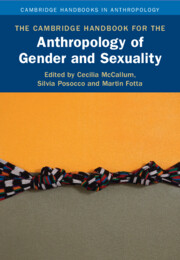Book contents
- The Cambridge Handbook for the Anthropology of Gender and Sexuality
- Cambridge Handbooks in Anthropology
- The Cambridge Handbook for the Anthropology of Gender and Sexuality
- Copyright page
- Contents
- Contributors
- 1 Introduction to The Cambridge Handbook for the Anthropology of Gender and Sexuality
- Part One Openings and Orientations
- Part Two Knowledges and Domains
- Part Three Resistances and Intersections
- 12 Social and Cultural Politics of Everyday Resistance and Empowerment
- 13 Reworking Black Feminist Anthropology through Transnational Scholar-Activism and Antiracist Solidarity in Africa and Its Diaspora
- 14 Gender in Decolonial Indigenous Perspectives
- 15 Anthropologies of Reproduction, Abortion, and Biopolitics
- 16 Gender, Capitalism, and the Erotics of Finance
- 17 Untying Poverty’s Gendered Knots Past and Present
- Part Four Desires and Relations
- Part Five Recursivities and Futures
- Name Index
- Subject Index
- References
14 - Gender in Decolonial Indigenous Perspectives
from Part Three - Resistances and Intersections
Published online by Cambridge University Press: 29 September 2023
- The Cambridge Handbook for the Anthropology of Gender and Sexuality
- Cambridge Handbooks in Anthropology
- The Cambridge Handbook for the Anthropology of Gender and Sexuality
- Copyright page
- Contents
- Contributors
- 1 Introduction to The Cambridge Handbook for the Anthropology of Gender and Sexuality
- Part One Openings and Orientations
- Part Two Knowledges and Domains
- Part Three Resistances and Intersections
- 12 Social and Cultural Politics of Everyday Resistance and Empowerment
- 13 Reworking Black Feminist Anthropology through Transnational Scholar-Activism and Antiracist Solidarity in Africa and Its Diaspora
- 14 Gender in Decolonial Indigenous Perspectives
- 15 Anthropologies of Reproduction, Abortion, and Biopolitics
- 16 Gender, Capitalism, and the Erotics of Finance
- 17 Untying Poverty’s Gendered Knots Past and Present
- Part Four Desires and Relations
- Part Five Recursivities and Futures
- Name Index
- Subject Index
- References
Summary
This chapter provides a critical review of the latest debates within Indigenous gender studies that aim to advance understanding and awareness of gender relations and gender-based ideologies shaped in response to socioeconomic upheavals associated with patriarchal colonialism. Drawing from a spate of recent publications of gender-focused Indigenous studies, the discussion examines what theoretical and onto-epistemological insights are offered by Indigenous scholars involved in attempts to trace gender conflicts and tensions while identifying their implications for the contemporary constructions of gender, sex, indigeneity, and decolonization. Focusing on the studies of Indigenous gender formations with their nonbinary, ungendered, or genderless foundations in the circumpolar North and beyond, the author looks at how Indigenous gender studies continue questioning and challenging the deep-seated heteropatriarchal divisions, colonial heteronormativity, biological determinism, and neocolonial discourses on indigeneity.
Keywords
- Type
- Chapter
- Information
- Publisher: Cambridge University PressPrint publication year: 2023
References
- 1
- Cited by



